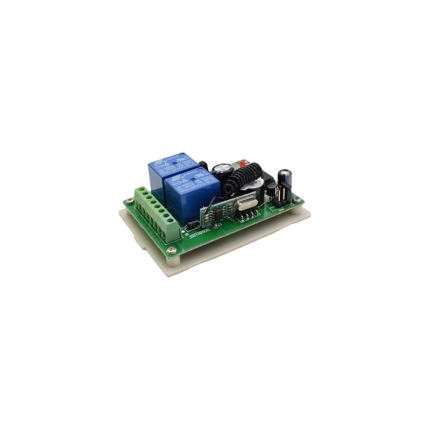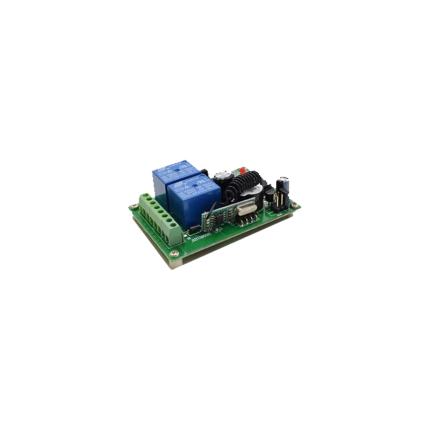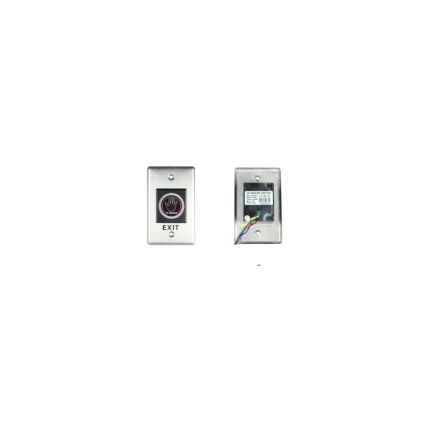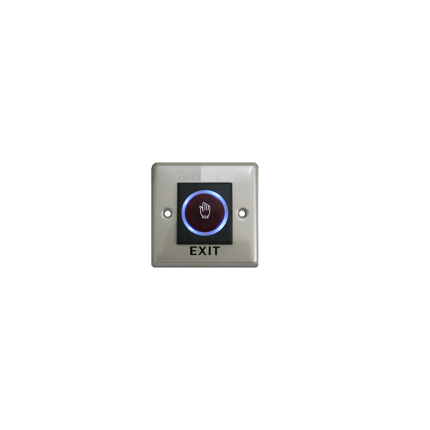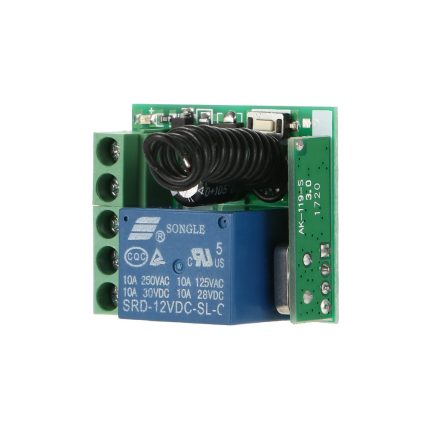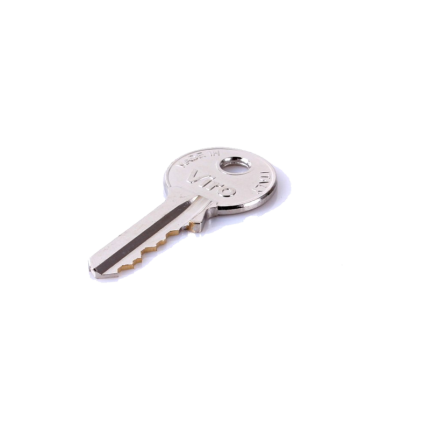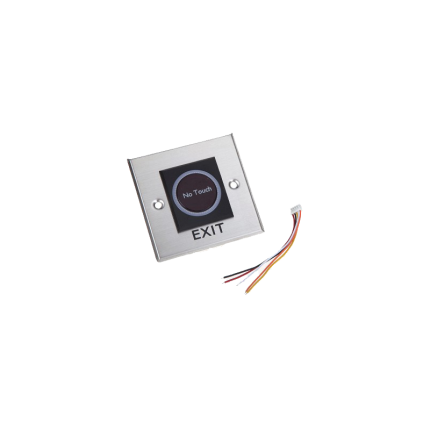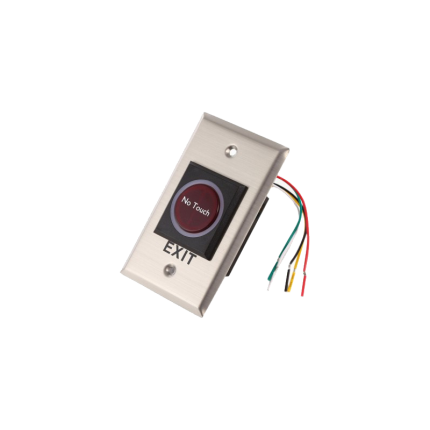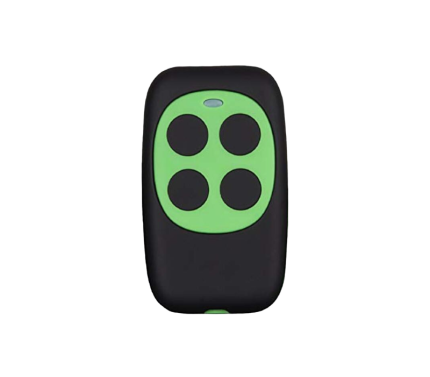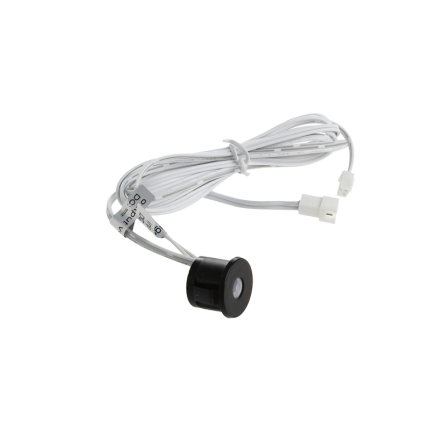Shop
Radio receiver RG433-24V2C
Ship or pick up from our office.
Radio receiver RG433-24V2C
* DC 24 V * 2 Channels * 433 MHz The RG433-24V2C is a 433 MHz radio receiver primarily used in automated gate systems to control the opening and closing of gates via a remote control. It acts as a crucial component for convenient and secure remote access. Key Features & Specifications 🔑- Frequency: Operates at 433 MHz, a common frequency for remote control applications.
- Channels: The "2C" in its designation suggests it has 2 channels, meaning it can control two different functions or devices.
- Voltage: It typically operates on a DC 24V power supply.
- Application: Primarily designed for gate opener remote control systems.
- Type: It can be an external receiver, often used as a backup or for added functionality in gate automation setups.
- Manufacturer: It's manufactured by Royal Electronics Technology Center Co. (RETCC).
Radio receiver RG433-12V2C
Ship or pick up from our office.
Radio receiver RG433-12V2C
*DC 12 V *2-CH *433 MHzRadio receiver RG433-24V1C
Ship or pick up from our office.
Radio receiver RG433-24V1C
* DC 24 V * 1 Channel * 433 MHz The Radio receiver RG433-24V1C is an electronic device primarily used in automated gate systems. It receives radio signals from a remote control, enabling it to open and close an automatic gate. 🚧 Key Features and Specifications- Frequency: It operates at 433 MHz, a common frequency for remote control applications.
- Voltage: It requires a DC 24V power supply. The "1C" in its name likely refers to its single channel capability, meaning it controls one function (e.g., opening/closing a single gate).
- Function: Its core function is to receive signals, decode commands, and then control the connected gate opener.
- Type: These receivers can be either internal (built into the gate opener unit) or external. External receivers are often used for added functionality or as backup.
- Physical Characteristics: It's a compact device, typically weighing around 0.08 kg with dimensions of approximately 8 × 6 × 3 cm.
- Remote Access: Allowing users to open and close gates wirelessly using a remote control.
- Security: Providing convenient and secure access to properties.
In essence, the RG433-24V1C acts as the "ear" for your automated gate, listening for commands from your remote control to manage access.
Radio receiver RG433-12V1C
Ship or pick up from our office.
Radio receiver RG433-12V1C
* DC 12 V * 1 Channel * 433 MHz The RG433-12V1C is a single-channel radio receiver operating at 433 MHz, specifically designed for remote control of automatic gates. It acts as a crucial component in automated gate systems, allowing users to open and close gates wirelessly using a remote control. This receiver is compact and lightweight, making it easy to install. It functions by receiving radio signals from a remote, decoding the commands, and then controlling the gate opener mechanism. Key Features- Frequency: Operates at 433 MHz, a common frequency for remote control devices.
- Channels: It's a 1-channel receiver, meaning it can control one specific function or device (in this case, typically opening/closing a single gate).
- Voltage: Designed to operate with a 12V DC power supply.
- Application: Primarily used in automated gate systems for remote access control.
- Dimensions: Approximately 8 × 6 × 3 cm.
- Weight: Around 0.08 kg.
- Compatibility: Compatible with various types of gate openers, including single swing, double swing, and sliding gates.
Manual release key – Swing/Sliding gate openers
Ship or pick up from our office.
Manual release key – Swing/Sliding gate openers
All types of sliding gate openers and swing gate operators have a manual release key to get the driveway gate operator into the manual mode. The manual release key shape and type are different, and depend on the brand and model of the driveway gate opener. To release a swing gate opener or sliding gate operator in emergency times when the driveway gate is closed, the gate operator is not working, and not opening the gate for any reason, the resident needs to open the gate using the release key.Gate Opener Remote Control
Ship or pick up from our office.
Gate Opener Remote Control
– Copy Code typeGate opener remote controls use two main code types for copying: fixed code and rolling code.
Fixed code remotes are simpler and easier to clone, while rolling code remotes offer enhanced security and require more advanced techniques for copying.
Gate Opener Remote Control Fixed Code type:
- How it works: A fixed code remote transmits the same code every time it's pressed.
- Cloning: These are generally easier to clone using a universal remote duplicator.
- Security: Less secure than rolling code, as the code can be intercepted and copied.
- Example: Commonly found in older or simpler gate opener systems.
Infrared PIR Motion Sensor Switch
Ship or pick up from our office.
Infrared PIR Motion Sensor Switch
An Infrared PIR Motion Sensor Switch is an electronic device that detects movement by sensing changes in infrared (IR) radiation in its field of view. "PIR" stands for Passive Infrared, meaning it doesn't emit any energy itself but rather passively monitors the infrared radiation given off by objects. 🌡️ How it Works At the core of a PIR sensor is a pyroelectric sensor, which is sensitive to heat (infrared radiation). Most PIR sensors have two halves, or "slots," wired in a differential arrangement. Here's a simplified breakdown of its operation:- Idle State: When there's no movement, both halves of the sensor detect the same amount of ambient infrared radiation from the surroundings.
- Motion Detection: When a warm object, like a human or animal, moves into the sensor's field of view, it first intercepts one half of the sensor, creating a temporary difference in the infrared radiation detected by the two halves. This difference generates a voltage pulse.
- Signal Processing: The sensor's circuitry processes this voltage pulse. If the change is significant and matches the pattern of a moving heat source, the sensor triggers an output signal.
- Fresnel Lens: A key component of a PIR sensor is the Fresnel lens . This specially designed plastic lens focuses infrared radiation from different angles onto the pyroelectric sensor, effectively dividing the detection area into multiple sensitive zones. This allows the sensor to have a wider field of view and detect movement more effectively.
- Automatic Lighting Control: This is one of the most common applications. PIR sensors turn lights on when someone enters a room, hallway, or outdoor area and turn them off after a set period of no motion, saving energy.
- Security Systems: They are integral to security alarms, detecting intruders and triggering alerts or security cameras.
- Smart Home Systems: PIR sensors play a role in smart homes for automating various functions, from lighting and HVAC systems to controlling appliances based on occupancy.
- Automatic Doors: In public buildings, they detect approaching individuals to automatically open doors.
- Energy Management: By ensuring that lights, HVAC, and other devices only operate when an area is occupied, PIR sensors contribute significantly to energy savings in residential and commercial settings.
- Wildlife Tracking and Research: Researchers use them to monitor animal movements without disturbance.
Gate Opener Remote Control
Ship or pick up from our office.
Gate Opener Remote Control
(More than 100 different designs) *433 MHz *2-5 Buttons A gate opener remote control is a handheld device that allows you to wirelessly open and close an automatic gate from a distance. It's a key component of an automated gate system, offering convenience and enhanced security for residential, commercial, and industrial properties. Here's a breakdown of what it is and how it works: What it is:- Handheld device: Typically small and portable, often designed to be kept in a car, on a keychain, or mounted on a visor.
- Transmitter: It contains a small radio transmitter that sends a wireless signal.
- User interface: Usually features one or more buttons to command the gate (e.g., open, close, stop).
- Signal Transmission: When you press a button on the remote, it sends a digitally encoded radio frequency (RF) signal (typically in the 300 to 900 MHz range) through the air.
- Signal Reception: A receiver unit, connected to the gate motor, is tuned to the same frequency as the remote. It picks up this signal.
- Signal Decoding: The receiver interprets the coded information embedded in the signal to understand the desired action (e.g., open the gate).
- Motor Activation: The decoded signal is sent to the gate's control board, which then activates the gate motor.
- Gate Movement: The motor, through various mechanisms (gears, chains, arms), physically moves the gate to open or close.
- Convenience: Allows you to operate the gate without leaving your vehicle, especially useful in bad weather or at night.
- Security: Provides controlled access to your property, deterring unauthorized entry. Many modern remotes use "rolling code" technology, which changes the code with each use, making it harder for unauthorized individuals to intercept and duplicate the signal.
- Range: Typically works within a certain distance, ranging from 20-50 feet up to 100 feet or more, depending on the model and environment.
- Compatibility: Most remotes are designed to work with specific gate opener brands and models, though universal remotes exist that can be programmed to work with various systems.
- Multiple Remotes: Many gate openers can be paired with multiple remotes, allowing several authorized users to control the gate.
- Integration: Some advanced systems can be integrated with smartphone apps, keypads, or other smart home devices for even greater control and monitoring.
- Safety Features: Often used in conjunction with safety sensors (like photo eyes or pressure sensors) that detect obstructions and prevent the gate from closing on people or objects.

